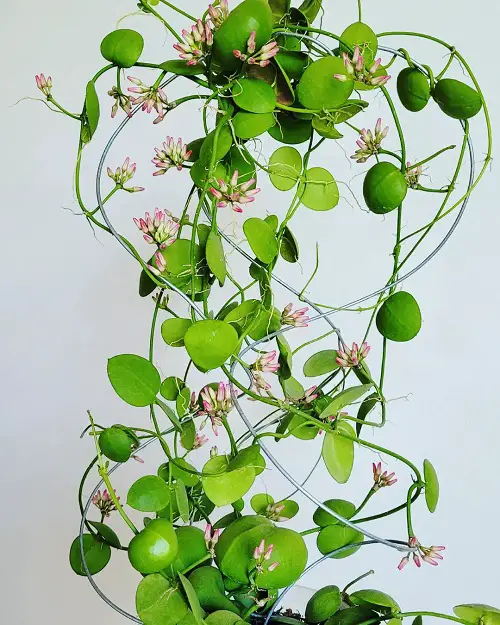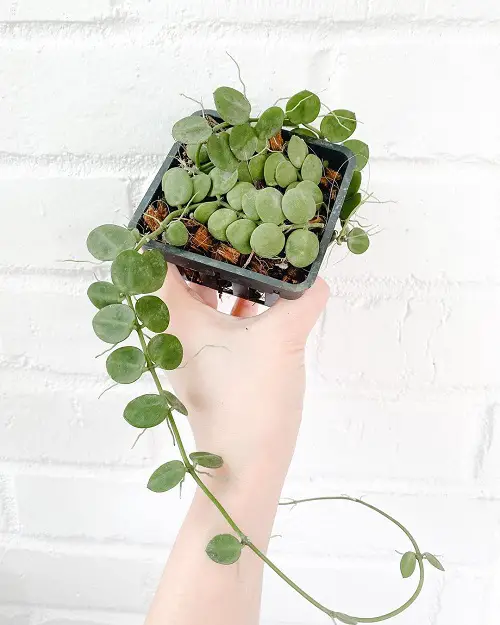Dischidia Major is a beautiful little specimen that can make for a fantastic addition to tabletops and shelves in the home!

Dischidia Major is a fascinating tropical species. However, growing and caring for it can be tricky. In this guide, we’ll provide you with essential tips and tricks to help you successfully grow and maintain this plant.
Learn How to Grow Dischidia Geri in the Pots
Dischidia Major Plant Information
Dischidia Major is a creeping, epiphytic vine native to Southeast Asia. It has glossy, ovate leaves with a slightly scalloped margin. The leaves are bright green, with a reddish hue to the underside.
The plant produces small, star-shaped white flowers in spring and summer, which are followed by small, round, red berries. Dischidia major is well-suited to hanging baskets and will trail from a tree or trellis.
Botanical Name: Dischidia major (Vahl) Merr.
Learn about Growing Dischidia Nummularia
Propagating Dischidia Major

- Start by taking a stem cutting with at least 4-5 leaves attached.
- Make sure that each cutting you take has a node, which is a small bump where the leaves and stem meet.
- Cut the stem just below the node, and remove the bottom leaves.
- Dip the cutting in a rooting hormone, and then plant it in a pot filled with moistened, well-drained soil.
- Place the pot in a warm, bright location and water it regularly. Keep an eye out for new growth and roots, which should appear in a few weeks.
- Once the roots have developed, you can transplant the cutting into a larger pot.
Requirements for Growing Dischidia Major

Light
Dischidia Major typically thrives in bright indirect lighting, consistent with its natural habitat where it grows under large trees. Direct sunlight can cause the plant to turn yellow and eventually burn.
Soil
It prefers a well-draining soil mix with a pH of 6.0-7.5. A good growing medium for Dischidia major would consist of a combination of orchid bark, coco coir, perlite, and peat moss. This combination would help to provide adequate drainage and aeration while still retaining some moisture.
Additionally, adding some charcoal or other organic matter to the mix can help to improve drainage and aeration even further.
You can also use a growing medium specifically designed for orchids to grow this plant.
Water
Watering for Dischidia Major is important to ensure the plant’s health. Generally, these plants need to be watered once every 7-10 days. During the growing season, it may be necessary to water more frequently. The soil should be kept lightly moist but not soggy.
During the winter months, it is best to reduce the amount of water and allow the soil to dry out between waterings.
Temperature and Humidity
Dischidia Major requires a warm and humid environment to thrive, typically a temperature range between 10C or 50F and 30C or 86F with a minimum of 50% humidity, which is consistent with their natural habitat. If humidity levels drop below this range, the plant’s growth rate may slow down, and the leaves could turn yellow.
To increase humidity levels around Dischidia Major, you can spray the surrounding area a few times a week. The fine water particles will evaporate slowly, increasing the humidity levels around the plant.
Learn How to Grow Dischidia Platphylla
Dischidia Major Care

Fertilizer
Dischidia Major does not require a significant amount of fertilizer due to their low water retention capacity. You can use a balanced liquid fertilizer, diluted to 1/4 of its strength, once in 8-10 weeks. This will give the plant an added boost to grow well.
Do not feed the plant in the winter months.
Pests and Diseases
Dischidia Major is often called an “ant’s nest” plant, so it is important to prevent ants from taking up residence in your plant. One effective method is to draw a chalk line around the plant, which can be surprisingly helpful in deterring ants.
Other pests include mealybugs, aphids, scale insects, spider mites, and root rot. These pests and diseases can be controlled with regular monitoring and pest control treatments such as horticultural oil or insecticidal soaps.
Overwatering and improper light levels can also cause root rot and leaf spots, which can be prevented by providing optimal growing conditions.


